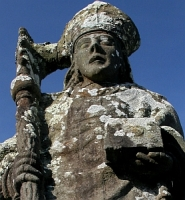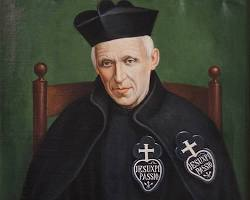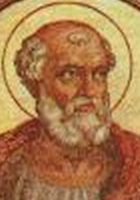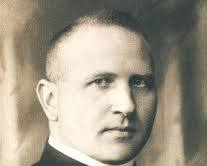Saint Juan Diego
மரியான் திருக்காட்சியாளர்:
பிறப்பு: கி.பி. 1474
குவாஹ்டிட்லன், மெக்ஸிகோ
இறப்பு: கி.பி. 1548 (வயது 73–74)
டெபேயக், மெக்ஸிகோ
ஏற்கும் சமயம்:
ரோமன் கத்தோலிக்க திருச்சபை
முக்திபேறு பட்டம்: மே 6, 1990
குவாதலுப் பேராலயம், மெக்ஸிகோ நகர்
திருத்தந்தை இரண்டாம் ஜான் பால்
புனிதர் பட்டம்: ஜூலை 31, 2002
குவாதலுப் பேராலயம், மெக்ஸிகோ நகர்
திருத்தந்தை இரண்டாம் ஜான் பால்
முக்கிய திருத்தலம்:
குவாதலுப் பேராலயம்
நினைவுத் திருநாள்: டிசம்பர் 9
பாதுகாவல்: பழங்குடி மக்கள் (Indigenous Peoples)
புனிதர் ஜுவான் டியெகோ, மெக்ஸிகோ நாட்டைச் சேர்ந்தவரும், அமெரிக்க நாடுகளின் பழங்குடியைச் சார்ந்த முதல் ரோமன் கத்தோலிக்க புனிதரும் ஆவார். “புனிதர் ஜுவான் டியேகோ குவாஹ்ட்லடோட்ஸின்” (Saint Juan Diego Cuauhtlatoatzin) மற்றும், “புனிதர் ஜுவான் டியெகோட்ஸில்” (Saint Juan Diegotzil) ஆகிய பெயர்களாலும் இவர் அறியப்படுகின்றார்.
கி.பி. 1531ம் ஆண்டு, டிசம்பர் மாதம், வெவ்வேறு நான்கு சம்பவங்களின்போது “டெபேயக்" மலைப் பகுதியிலும், (Hill of Tepeyac) பின்னர் மலைப்பகுதியின் வெளியேயும் (தற்போதைய மெக்ஸிகோ பெருநகரம்) இவருக்கு அன்னை மரியாளின் தரிசனம் கிட்டியதாக கூறப்படுகிறது.
ஜுவான் டியெகோவுக்கு அன்னை மரியாளின் தரிசனம் கிட்டியதன் நம்பகத்தன்மையை உறுதி செய்யும் வகையில், "டெபேயக்" (Tepeyac) மலையின் அடிவாரத்தில் அமைந்திருக்கும் "குவாதலுப் திருத்தலத்தில்" புனிதர் ஜுவான் டியெகோவின் 'டில்மா' (Tilma) என்றழைக்கப்படும் அங்கி அல்லது சால்வை இருப்பதாகவும் அதன்மேலே அன்னை கன்னி மரியாளின் தூய உருவம் பதிந்திருப்பதாகவும் அறியப்படுகின்றது. இந்த அதிசய சித்திரத்தை கொடுப்பதற்காகவே தூய அன்னை தரிசனம் தந்ததாகவும் அதன் காரணமாகவே மலையடிவாரத்தில் தோன்றிய திருத்தலம் "குவாதலுப் அன்னை திருத்தலம்" என்ற பெயரில் வழிபடப்படுகிறது எனவும் சொல்கிறார்கள். இதனால் இந்த திருத்தலத்தின் வல்லமைகளும் பெருமைகளும் ஸ்பேனிஷ் மொழி பேசும் அமெரிக்கர்களிடையேயும், அதற்கப்பாலும் பரவி, இன்று உலகளவில் கத்தோலிக்க திருயாத்திரைத் தலமாக மாறியுள்ளது.
"டாக்டர் மிகுவேல் லியோன்-போர்டில்லா" (Dr. Miguel León-Portilla) போன்ற மெக்ஸிகன் அறிஞர்களின் கூற்றுப்படி, கி.பி. 1474ம் ஆண்டு மெக்ஸிகோவில் பிறந்த ஜுவான் டியெகோ, ஒரு இந்திய வம்சாவளி ஆவார். இவர் செல்வந்தரோ செல்வாக்குள்ளவரோ கிடையாது. இவரது தனிப்பட்ட வாழ்க்கையைப் பற்றி வெவ்வேறு கதைகள் கூறப்படுகின்றன. இவர் திருமணம் ஆனவர் என்றும், ஒரு மகன் இருந்தார் என்றும் ஒரு கதை. திருமணம் ஆகியும் கடைசிவரை கன்னித்தன்மையுடன் வாழ்ந்தனர் என்றொரு கதை. நற்செய்தி பிரசங்கம் ஒன்றினால் ஈர்க்கப்பட்ட இவர்கள் கற்புநெறி வாழ்க்கை வாழ்ந்தனர் என்றும் கூறுவார். ஆனால், எதற்கும் உறுதியான ஆதாரங்கள் கிடையாது.
கி.பி. 1524ம் ஆண்டில், முதன்முறையாக மெக்ஸிகோ வந்த பிரான்சிஸ்கன் மிஷனரிகளின் முதல் குழுவினரால் ஜுவான் டியெகோவும் அவரது மனைவி என்று அறியப்படும் 'மரியா லூசியாவும்' (María Lucía) திருமுழுக்கு பெற்றனர். இவருக்கு அன்னையின் தரிசனம் கிடைப்பதற்கு இரண்டு வருடங்களுக்கு முன்னரேயே இவரது மனைவி மரித்துப்போனார்.
இவருக்கு கத்தோலிக்க மறையின் மீதிருந்த உற்சாகமான ஈர்ப்பும் அன்னை மரியாளின் மீது இவர் கொண்டிருந்த அளவற்ற மரியாதையும் பக்தியும் இவரது வெள்ளை மனமும் கருணையுடன் பிறருடன் பழகும் அணுகுமுறையும் இவரது புனிதர் பட்டம் வழங்குவதற்கான ஆரம்ப கட்ட பணிகளின் தவிர்க்க இயலாத அளவுகோல்களாக அமைந்தன என்பர்.
இவருக்கு அன்னை மரியாளின் தரிசனம் கிட்டியதன் பின்னர், இவர் டெபேயக் மலை அடிவாரத்தில் அமைந்திருந்த துறவு மடத்தின் அருகே வசிக்க அனுமதிக்கப்பட்டார். அவர் தமது வாழ்வின் இறுதிவரை அருகிலேயே அமைந்திருந்த அன்னை குவாதலுப் திருத்தலத்தில் சேவை செய்து வாழ்ந்தார்.
Also known as
• Cuauhtlatoatzin
• Juan Diego Cuautlatoatzin
Profile
Born an impoverished free man in a strongly class-conscious society. Farm worker, field labourer, and mat maker. Married layman with no children. A mystical and religious man even as a pagan, he became an adult convert to Christianity around age 50, taking the name Juan Diego. Widower in 1529. Visionary to whom the Virgin Mary appeared at Guadalupe on 9 December 1531, leaving him the image known as Our Lady of Guadalupe.
Born
1474 Tlayacac, Cuauhtitlan (about 15 miles north of modern Mexico City, Mexico) as Cuauhtlatoatzin
Died
30 May 1548 of natural causes
Beatified
• 9 April 1990 by Pope John Paul II at Vatican City
• recognition celebrated on 6 May 1990 at Mexico City, Mexico
Canonized
• 31 July 2002
• recognition celebrated at the basilica of Our Lady of Guadalupe, Mexico by Pope John Paul II
Saint Peter Fourier
புனித பேதுரு ஃபோரியர்
நினைவுத்திருநாள் : டிசம்பர் 9
பிறப்பு : 30 நவம்பர் 1565, லோத்ரிங்கன் Lothringen, பிரான்ஸ்
இறப்பு : 9 டிசம்பர் 1640, கிரே Gray, பிரான்ஸ்
முத்திபேறுபட்டம்: 1730
புனிதர்பட்டம்: 7 மே 1897, திருத்தந்தை 13 ஆம் லியோ
இவர் தனது 20 வயதில் 1589 ஆம் ஆண்டு டிரியரிலுள்ள சிமியோன் ஆலயத்தில் குருவாக திருநிலைப்படுத்தப்பட்டார். அதன்பிறகு தான் பிறந்த ஊரின் பக்கத்து ஊரிலேயே மறைப்பணிக்காக அனுப்பப்பட்டார். இவர் அவ்வூரில் முதல் திருப்பலி நிறைவேற்றிய போது ஆற்றிய மறையுரையால் பலர் மனந்திரும்பி, உண்மையுள்ள கிறிஸ்தவர்களாக மாறினர். இவர் ஊர் ஊராக கால்நடையாகவே சென்று மறைப்பணியாற்றினார். இவர் குருவான சில ஆண்டுகளிலேயே பல பங்குகளை உருவாக்கினார். ஒவ்வொரு ஊர்களிலும் தவறாமல் திருப்பலியை நிறைவேற்றினார்.
இவர் இளைஞர்களுக்கு மிக முக்கியத்துவம் கொடுத்து அவர்களின் மனதில் இடம்பிடித்தார். இளைஞர்களை பராமரிப்பதற்கென்று 1597 ஆம் ஆண்டு சபை ஒன்றை தொடங்கினார். இச்சபையானது தொடங்கிய 25ஆண்டுகளில் உலகம் முழுவதும் பரவியது. இச்சபையை திருத்தந்தை 5 ஆம் பவுல் துறவற சபையாக அறிவித்து அங்கீகாரம் அளித்தார். மிக சிறப்பாக பணியாற்றிய இவர் சிறந்த குரு என்றழைக்கப்பட்டு புகழப்பட்டார்.
Also known as
Also known as
• Good Father of Mattaincourt
• Le Bon Père de Mattaincourt
Profile
Educated at the University of Pont-a-Mousson, entering at age 15. Tutor to the sons of many noble families. Augustinian Canon Regular at the abbey in Chaumousey, France. Ordained in 1589. He returned to university, became a master of patristic theology, and could recite the Summa Theologica of Saint Thomas Aquinas by heart. Reforming priest at Mattaincourt, Vosges, France, an area noted for corruption and lax attitudes to heresy; he revitalized the spiritual life of the district, and established charities and banks for the poor. Spiritual teacher of Blessed Alix le Clerc. In 1598 he founded the Daughters of Our Lady for the education of girls. Founded the Sodality of the Immaculate Conception, or Children of Mary. His attempt to found a parallel order to teach boys failed. In 1621 he was ordered to reform his order in Lorraine. In 1625 he was sent to Salm to preach missions and work against Calvinism; within six months all the fallen away Catholics had returned to the Church. Helped found the Congregation of Our Saviour in 1629 and served as its superior general in 1632. When the French government ordered him to swear allegiance to King Louis XIII he refused, and spent the rest of his life in exile in the town of Gray, Haute-Saone, France.
Born
30 November 1565 at Mirecourt, Lorraine (modern France)
Died
9 December 1640 at Gray, Haute-Saone (modern France) of natural causes
Beatified
20 January 1730 by Pope Benedict XIII
Canonized
27 May 1897 by Pope Leo XIII
Blessed Liborius Wagner
Also known as
Liborio
Profile
Raised a Protestant, he studied in Mühlhausen, Leipzig, Gotha and Strasbourg, then in 1621 began studying with Jesuits in Würzburg, Germany where he converted to Catholicism. Ordained on 29 March 1625, Liborius served as chaplain in Hardheim, Germany, then as parish priest at Altenmünster, Germany a predominently Protestant city. He ministered to everyone in his city, and his example brought many Protestants to re-union with the Catholic Church. In 1631, the Protestant Swedes, fighting in the Thirty Years' War, reached Altenmünster, and Father Liborius was forced to flee the city; he hid in Reichmannhausen, which was only couple of miles away, so he could return to minister to his parishioners. On 4 December 1631 he was betrayed, captured by the Swedes, tied behind a horse, and dragged several miles to the castle of Mainberg where he was subjected to several days of torture to force him to renounce the Catholic Church; he refused. Martyr.
Born
5 December 1593 at Mühlhausen, Unstrut-Hainich, Thuringia, Germany
Died
• beaten to death with swords and firearms on 9 December 1631 on the River Main, Schonungen, Schweinfurt, Germany
• stripped of his priestly garb to make identification harder, and his body thrown into the River Main
• body recovered from the river by area Catholics, and buried nearby
• following the end of Swedish rule in the area, his body was re-interred in the chapel of the castle of Mainberg
• re-interred in the parish church of San Lorenzo, Heidenfeld, Germany on 15 December 1637
Beatified
24 March 1974 by Pope Paul VI
Blessed Clara Isabella Fornari
Also known as
• Anna Felecia Fornari
• Chiara Fornari
Profile
Novice in the Poor Clares of Todi, Italy at age 15, and took her vows under the name Clara Isabella at 16. Given to long and frequent ecstatic visions of Jesus, Our Lady, Saint Clare of Assisi, and Saint Catherine of Siena. During one of these, Jesus placed a ring on her finger, and pronounced her his "spouse of sorrow."
Stigmatist, with constant marks and periodic bleeding. Her head was weighted with a mystical crown of thorns that invisibly, but painfully, grew through the skin until the thorns popped through and fell, leaving bleeding open wounds.
Driven to depression and despair from the pain, she was tempted to apostasy and suicide. Toward the end of her short life she even lost the memories of her earlier, consoling visits from Heaven. However, not long before she died the memories of those earlier, ecstatic times returned to her, her joy in God returned, and she went happily into the next life.
Born
25 June 1697 at Rome, Italy as Anna Felicia Fornari
Died
9 December 1744
Saint Nectarius of Auvergne
Also known as
• Nectarius of Limagne
• Nectarius of Senneterre
• Nectarius of St-Nectaire
• Nectaire, Necterius
Profile
Missionary sent by Pope Saint Fabian to take the faith into Gaul in the 3rd century, centering his work around the modern Auvergne, France. Worked with Saint Austremonius, Saint Gatianus of Tours, Saint Trophimus of Arles, Saint Paul of Narbonne, Saint Martial of Limoges, Saint Dionysius of Paris, Saint Baudimius, Saint Auditor of Saint-Nectaire and Saint Saturninus of Toulouse; may have been related to Baudimus and/or Auditor. Turned a pagan temple into the new Christian church. Martyr.
Died
• murdered by the pagan chieftain Bradulus
• the Benedictine priory of St-Nectaire, France was built over his grave
• the small town of Saint-Nectaire, Puy-de-Dôme grew up around it, giving it's name to a world famous cheese
Saint Leocadia of Toledo
புனித_லியோகாதியா (-303)
டிசம்பர் 09
இவர் (#StLeocadiaOfToledo) ஸ்பெயின் நாட்டில் உள்ள ஸடொலேதோ என்ற இடத்தில் இருந்த ஒரு மதிப்புமிக்க குடும்பத்தில் பிறந்தவர்.
இவரது காலத்தில் உரோமை ஆண்டுவந்த தியோகிளசியன் என்ற மன்னன் கிறிஸ்தவர்களைப் பிடித்துத் துன்புறுத்தியும் கொலை செய்தும் வந்தான்.
தியோகிளசியன் மன்னனுக்குக் கீழ் ஆளுநராக இருந்தவன் டெசியானுஸ் என்பவன். அவன் லியோகாதியா கிறிஸ்துவின்மீது மிகுந்த பற்றுக்கொண்டிருப்பதை அறிந்து, பலவந்தமாக இழுத்துச் சென்று, மிக கொடுமையாகச் சித்திரவதை செய்து, கிறிஸ்துவை மறுதலிக்கச் சொன்னான். ஆனால் இவர் தனது நம்பிக்கையில் மிக உறுதியாக இருந்ததால், அவன் இவரைச் சிறையில் தள்ளி, மீண்டுமாகச் சித்திரவதை செய்தான்.
இதற்கு நடுவில் யுலேலியா என்ற புனிதை தன்னைப் போன்று சித்திரவதை செய்யப்படுவதை அறிந்து, இவர் மிகவும் வருந்தினார். அவருக்காக இவர் தொடர்ந்து மன்றாடினார்.
சிறையில் இவருக்குக் கொடுக்கப்பட்ட தண்டனை மிகுதியானதால், இறைவனிடத்தில் இவர் தனது உயிரை எடுத்துக்கொள்ளுமாறு மன்றாடினார். அதன் படி இவர் டிசம்பர் 9ஆம் நாள் இறையடி சேர்ந்தார்.
Also known as
Locaie of Toledo
Profile
Slave. Beaten and imprisoned for refusing to denounce her faith during the Diocletian persecutions. Scheduled for torture and either apostasy or martyrdom, she learned of the abuse being suffered by the 13 year old Saint Eulalia of Merida. Leocadia prayed for God to remove her from a world where such evil occurred; she died soon after, of no particular cause, without being touched by her torturers. Ancient and popular cultus developed in Toledo, Spain.
Died
• c.303 at Toledo, Spain of (super) natural causes
• relics translated 26 April 1589
Saint Budoc of Brittany
Also known as
• Budoc of Dol
• Beuzec, Beuzeg, Beuzegig, Bozeg, Bozel, Budeaux, Budeg, Budeux, Budock, Budog, Budogan, Budok, Budokus, Buoc
Profile
Born a prince, the son of a king of Brittany; his mother was Azenor, princess of Brest, France. Legend says that his mother was set adrift in a cask, and that Budoc was born at sea with Saint Brigid of Ireland in attendance. Educated in a monastery near Waterford, Ireland. Abbot at Youghal, Ireland. Bishop of Dol, Brittany for 26 years. Several places in Devon and Cornwall in England are named after him.
Born
in Brittany (part of modern France)
Saint Syrus of Pavia
Also known as
Cyril, Siro
Profile
Evangelized and served as first bishop of Pavia, Italy in the 1st century; tradition says that he was appointed by the Apostles, and an old legend says that he was the boy with five loaves who appears in the Gospels. Worked with Saint Juventius of Pavia. Fought Arianism.
Died
relics in the cathedral of Pavia, Italy
Saint Gorgonia
Profile
Daughter of Saint Gregory of Nazianzen the Elder and Saint Nonna. Sister of Saint Gregory of Nazianzen and Saint Caesarius of Nazianzen. Married, and mother of three. Twice miraculously cured of serious maladies, one of which resulted from being trampled by a team of mules which broke bones and crushed internal organs, and the other whose symptoms included headaches, fever, paralysis, and repeated coma. Each was cured by the strength of her prayer.
Died
c.375 of natural causes
Saint Valeria of Limoges
Profile
Daughter of an imperial Roman senator. Convert. Spiritual student of Saint Martial of Limoges. Betrothed in an arranged marriage, she said that she wanted to devote herself to God; her fiancee refused to believe it, assumed she had another lover, and killed her. Martyr. Possibly apocryphal.
Died
beheaded in Limoges, France
Saint Auditor of Saint-Nectaire
Also known as
Auditeur
Profile
Missionary sent by Pope Saint Fabian to take the faith into Gaul in the 3rd century, centering his work around the modern Auvergne, France. Worked with Saint Austremonius, Saint Gatianus of Tours, Saint Trophimus of Arles, Saint Paul of Narbonne, Saint Martial of Limoges, Saint Dionysius of Paris, Saint Baudimius, Saint Nectarius of Auvergne and Saint Saturninus of Toulouse; may have been related to Baudimus and/or Nectarius.
Saint Proculus of Verona
Profile
Bishop of Verona, Italy. Made public confession of his faith during the persecutions of Diocletian, for which he he was harassed, beaten and run out of town. He eventually returned to resume leadership of his flock.
Died
c.320 at Verona, Italy of natural causes
Saint Ethelgiva of Shaftesbury
Also known as
AEthelgifu of Shaftesbury
Profile
Princess, the daughter of King Alfred the Great. Nun. With her father's help, she founded and served as first abbess of Shaftesbury Abbey in Dorset, England.
Died
896
Saint Cyprian of Périgueux
Profile
Sixth century monk at Périgueux, France. In late life he became a hermit on the banks of the River Dordogne. Saint Gregory of Tours wrote a biography of him.
Died
586 of natural causes
Saint Balda of Jouarre
Profile
Late 7th century abbess in Jouarre Abbey, diocese of Meaux, France.
Died
relics in the abbey church at Nesle-la-Reposte, diocese of Troyes, France
Saint Caesar of Korone
Profile
First century convert. Spiritual student of Saint Paul the Apostle. One of the 72 disciples sent out to spread the faith at the beginning of the Church. Bishop.
Saint Wulfric of Holme
Also known as
Wolfeius of Holme
Profile
View other drafts
Saint Wulfric of Holme, also known as Wolfeius of Holme, was a 10th-century hermit and saint. He lived as a recluse at Saint Benet Hulme in Norfolk, England, where he devoted his life to prayer and contemplation.
Little is known about Saint Wulfric's life, but he is believed to have been a Saxon nobleman who renounced his worldly possessions and titles to embrace a life of solitude and piety. He chose Saint Benet Hulme, a remote and windswept island in the Norfolk marshlands, as his hermitage. There, he built a small cell and lived a simple life of prayer, fasting, and manual labor.
Saint Wulfric's holiness and devotion attracted pilgrims from all over England. They sought his counsel and guidance, and many were said to have been healed through his prayers. He was also known for his gift of prophecy, and he is said to have accurately predicted the deaths of several kings and queens.
Saint Wulfric died on December 9th, sometime in the 10th century. He was buried at Saint Benet Hulme, and his tomb soon became a popular pilgrimage site. His feast day is still celebrated on December 9th, and he is remembered as a model of Christian piety and humility.
There is no known image of Saint Wulfric of Holme, but he is often depicted in art as an old man with a long beard, dressed in a simple hermit's robe. He is sometimes shown holding a staff or a book, and he may be accompanied by a bird or a wild animal, symbolizing his connection to nature.
Saint Wulfric's story is a reminder that true happiness and fulfillment can be found in a life of simplicity and devotion to God. His example continues to inspire people of all faiths to seek a deeper connection with the divine and to live a life of purpose and meaning.
Died
c.1000
Saint Cephas
Profile
First century convert. Spiritual student of Saint Paul the Apostle. One of the 72 disciples sent out to spread the faith at the beginning of the Church.
Saint Julian of Apamea
Profile
Third century bishop of Apamea, Syria. Worked against the Montanist and Kata-Phrygian heresies.
Blessed Mercedarian Fathers
Profile
The memorial of ten Mercedarian friars who were especially celebrated for their holiness.
• Arnaldo de Querol • Berengario Pic • Bernardo de Collotorto • Domenico de Ripparia • Giovanni de Mora • Guglielmo Pagesi • Lorenzo da Lorca • Pietro Serra • Raimondo Binezes • Sancio de Vaillo •
Martyrs of North Africa
Profile
Twenty-four Christians murdered together in North Africa for their faith. The only details to survive are four of their names - Bassian, Peter, Primitivus and Successus.
Martyrs of Samosata
Profile
Seven martyrs crucified in 297 in Samosata (an area of modern Turkey) for refusing to perform a pagan rite in celebration of the victory of Emperor Maximian over the Persians. They are - Abibus, Hipparchus, James, Lollian, Paragnus, Philotheus and Romanus.
Died
crucified in 297 in Samosata (an area in modern Turkey)
Martyred in the Spanish Civil War
• Blessed Carmen Rodríguez Banazal
• Blessed Dolores Broseta Bonet
• Blessed Estefanía Irisarri Irigaray
• Blessed Isidora Izquierdo García
• Blessed José Ferrer Esteve
• Blessed José Giménez López
• Blessed Josefa Laborra Goyeneche
• Blessed Josep Lluís Carrera Comas
• Blessed Julián Rodríguez Sánchez
• Blessed María Pilar Nalda Franco
• Blessed Recaredo de Los Ríos Fabregat
Bernhard Mariea Silvestrelli
Born as Cesare Silvestrelli on November 7, 1831, in Rome, Italy
Son of a noble and wealthy family
Entered the Passionist Congregation in 1854, taking the name Bernard Mary of Jesus
Ordained a priest in 1855
Held various important positions within the Congregation, including Director of students, Master of novices, Local Superior, Consultor, Provincial Superior, and Superior General (for 25 years)
Founded new monasteries in Latin America, Bulgaria, and Australia
Reformed the Passionist Rule, emphasizing a return to the original spirit and charism of the Congregation
Died on December 9, 1911, in Moricone, Italy
Beatified by Pope John Paul II on May 15, 1994
Blessed Bernhard Maria Silvestrelli was known for his holiness, his zeal for the Passionist charism, and his leadership abilities. He was a tireless worker who traveled extensively throughout his life, founding new communities and strengthening existing ones. He was also a gifted writer and speaker, and his works continue to inspire Passionists and other Catholics today.
Michaela Andrusikiewicz
Michaela Andrusikiewicz: A Life Dedicated to Service and Faith
Michaela Andrusikiewicz was a Polish Norbertine nun who left a lasting mark on her community and beyond. Here's a glimpse into her remarkable life:
Early Life and Calling:
Born on January 11, 1865, in Modlnica, Poland.
Joined the Premonstratensian convent (Norbertine Sisters) in Krakow in 1888, taking the name Michaela.
Embraced various roles within the convent – teacher, librarian, and leader of the lay sisters.
Key Achievements and Contributions:
Instrumental in founding a new Norbertine community in the Czech Republic in 1902.
Oversaw the establishment of two additional houses for the Norbertine Sisters.
Served as novice mistress, guiding young women on their spiritual journey.
Became the first Prioress of the new Congregation of Norbertine Sisters in the Czech Republic.
Led the Congregation through its early years, fostering its growth and development.
Legacy and Recognition:
Beloved by her sisters for her kindness, wisdom, and leadership.
Remembered for her dedication to education, prayer, and serving others.
Honored as "Blessed Michaela Andrusikiewicz" by the Norbertine Order.
Her feast day is celebrated on December 9th, the anniversary of her death in 1926.
























